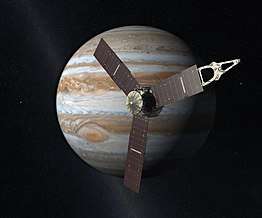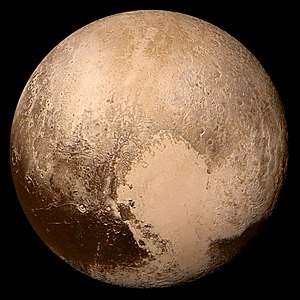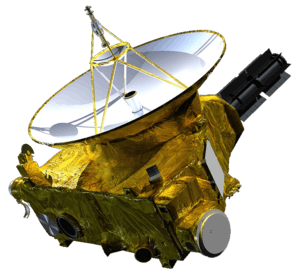New Frontiers program
The New Frontiers program is a series of space exploration missions being conducted by NASA with the purpose of researching several of the Solar System bodies, including the dwarf planet Pluto.

NASA is encouraging both domestic and international scientists to submit mission proposals for the program.[2] New Frontiers was built on the innovative approach used by the Discovery and Explorer Programs of principal investigator-led missions. It is designed for medium-class missions that cannot be accomplished within the cost and time constraints of Discovery, but are not as large as Large Strategic Science Missions (Flagship missions).
There are currently three New Frontiers missions in progress and one in development. New Horizons, which was launched in 2006 and reached Pluto in 2015, Juno, which was launched in 2011 and entered Jupiter orbit in 2016, and OSIRIS-REx, launched in September 2016 towards asteroid Bennu for detailed studies from 2018 to 2021 and a sample return to Earth in 2023.
On June 27, 2019, Dragonfly was selected to become the fourth mission in the New Frontiers program.[3][4]
History

The New Frontiers program was developed and advocated by NASA and granted by Congress in CY 2002 and 2003. This effort was led by two long-time NASA executives at Headquarters at that time: Edward Weiler, Associate Administrator of Science, and Colleen Hartman, Solar System Exploration Division Director. The mission to Pluto had already been selected before this program was successfully endorsed and funded, so the mission to Pluto, called New Horizons, was "grandfathered" into the New Frontiers program.
The 2003 Planetary Science Decadal Survey from the National Academy of Sciences identified destinations that then served as the source of the first competition for the New Frontiers program. The program name was selected by Hartman based on President John F. Kennedy's speech in 1960, in which he said "We stand, today, on the edge of a New Frontier."
Examples of proposed mission concepts include two broad groups based on Planetary Science Decadal Survey goals.[5]
- From New Frontiers in the Solar System: An Integrated Exploration Strategy
- Kuiper Belt Pluto Explorer (realized in New Horizons)
- Jupiter Polar Orbiter with Probes (led to Juno)
- Venus In Situ Explorer
- Lunar South Pole-Aitken Basin Sample Return Mission
- Comet Surface Sample Return Mission: Comet Astrobiology Exploration Sample Return (CAESAR) (see also the similar OSIRIS-REx, which is planned for a near-Earth object, not a comet.)
- From Vision and Voyages for Planetary Science in the Decade 2013–2022
- Io Volcano Observer
- Lunar Geophysical Network
- Saturn Atmospheric Entry Probe
- Trojan Tour and Rendezvous
Missions in progress
New Horizons (New Frontiers 1)
New Horizons, a mission to Pluto, was launched on January 19, 2006. After a Jupiter gravity assist in February 2007 the spacecraft continued towards Pluto. The primary mission flyby occurred in July 2015 and the spacecraft was then targeted toward one Kuiper Belt object called 486958 Arrokoth for a January 1, 2019 flyby. Another mission that was considered with this mission was New Horizons 2.
Juno (New Frontiers 2)

Juno is a Jupiter exploration mission which launched on August 5, 2011 and arrived in July 2016. It is the first solar-powered spacecraft to explore an outer planet. The craft was placed into a polar orbit in order to study the planet's magnetic field and internal structure. NASA's Galileo mission to Jupiter provided extensive knowledge about its upper atmosphere, however, further study of Jupiter is crucial not only to the understanding of its origin and nature of the Solar System, but also of giant extrasolar planets in general. The Juno spacecraft investigation is intended to address the following objectives for Jupiter:
- Understand Jupiter's gross dynamical and structural properties through determination of the mass and size of Jupiter's core, its gravitational and magnetic fields, and internal convection;
- Measure the Jovian atmospheric composition, particularly the condensable-gas abundances (H2O, NH3, CH4 and H2S), the Jovian atmospheric temperature profile, wind velocity profile, and cloud opacity to greater depths than achieved by the Galileo entry probe with a goal of 100 bar at multiple latitudes; and
- Investigate and characterize the three-dimensional structure of Jupiter's polar magnetosphere.
OSIRIS-REx (New Frontiers 3)
.png)
OSIRIS-REx stands for "Origins, Spectral Interpretation, Resource Identification, Security, Regolith Explorer", and was launched on 8 September 2016.[6] This mission plan is to orbit an asteroid, at the time named 1999 RQ36 (now 101955 Bennu), by 2020. After extensive measurements, the spacecraft will collect a sample from the asteroid's surface for return to Earth in 2023. The mission, excluding the launch vehicle, is expected to cost approximately $800 million. The returned sample will help scientists answer long-held questions about the formation of the Solar System and the origin of complex organic molecules necessary for the origin of life.
Asteroid Bennu is a potential future Earth impactor and is listed on the Sentry Risk Table with the third highest rating on the Palermo Technical Impact Hazard Scale (circa 2015).[7] In the late 2100s there is a cumulative chance of about 0.07% it could strike Earth, therefore there is a need to measure the composition and Yarkovsky effect of the asteroid.[8]
Planned missions
Dragonfly (New Frontiers 4)

On 27 June 2019, NASA announced the selection of Dragonfly as the New Frontiers mission #4 for a launch in 2026.[9]
Dragonfly will send a mobile robotic rotorcraft to Saturn's biggest moon Titan[10] and will make use of Multi-Mission Radioisotope Thermoelectric Generators (MMRTG) for power to navigate through the atmosphere of Titan.[2][11][12] The development cost cap is approximately $1 billion.[13]
Submitted mission concepts
The competition for the fourth mission began in January 2017. Out of 12 initial proposals, NASA selected two for additional concept studies on 20 December 2017, including Dragonfly.[14]
Per recommendation by the Decadal Survey, NASA's announcement of opportunity was limited to six mission themes:[13]
- Comet Surface Sample Return - a comet nucleus lander and sample return mission
- Lunar South Pole Sample Return - a mission to land at the Moon's South Pole–Aitken basin and return samples to Earth
- Ocean Worlds (Titan and/or Enceladus)
- Saturn Probe - an atmospheric probe
- Trojan Tour and Rendezvous - a mission to fly by two or more Trojan asteroids
- Venus Lander
The Decadal Survey recommended the Io Observer and Lunar Geophysical Network proposals for New Frontiers 5, in addition to the previous recommendations.[15] NASA received and reviewed 12 proposals (with the two finalists denoted in bold):[13][16]
- Comet Surface Sample Return
- Comet Nucleus Dust and Organics Return (CONDOR), to retrieve a sample from 67P/Churyumov–Gerasimenko.[16][17]
- Comet Rendezvous, Sample Acquisition, Investigation, and Return (CORSAIR) would sample comet 88P/Howell.[16][18]
- Comet Astrobiology Exploration Sample Return (CAESAR) to comet 67P/Churyumov–Gerasimenko
- Lunar South Pole Sample Return
- MoonRise, a sample return mission to explore the lunar South Pole–Aitken basin
- Ocean Worlds
- Oceanus, an orbiter to investigate Titan's potential habitability.[19]
- Dragonfly, a rotorcraft that would fly over the landscape and oceans of Titan to study prebiotic chemistry.[10][20]
- Enceladus Life Finder (ELF), an astrobiology orbiter to Enceladus.[21][22][23]
- Enceladus Life Signatures and Habitability (ELSAH)[16][24]
- Saturn Probe
- Saturn PRobe Interior and aTmosphere Explorer (SPRITE), an atmospheric probe to investigate Saturn's atmosphere and composition.[25]
- Trojan Tour and Rendezvous
- None
- Venus Lander
- Venus In Situ Atmospheric and Geochemical Explorer (VISAGE), a Venus atmospheric probe and lander.[26]
- Venus In situ Composition Investigations (VICI),[16][27] a lander.
- Venus Origins Explorer (VOX),[28] a Venus orbiter.
The two finalists, CAESAR and Dragonfly, each received $4 million funding through the end of 2018 to further develop and mature their concepts,[29] and NASA selected in June 2019 to build and launch Dragonfly.[30]
New Frontiers 5
The Decadal Survey recommends that two New Frontiers missions be selected per decade. The 2018 Midterm Review of the 2013–2022 Decadal Survey found that NASA is falling behind on this cadence, and recommends the release of the New Frontiers 5 Announcement of Opportunity no later than December 2021.[31] Thomas Zurbuchen, Associate Administrator for the Science Mission Directorate, responded positively to the Midterm Review's recommendation, stating that NASA is "committed to conducting two New Frontiers competitions per decade" and currently plans to release the Announcement of Opportunity in 2021 or 2022,[32] though the Midterm Review estimates a release date as late as 2023.[31]
As of January 2020, NASA plans to release the New Frontiers 5 Announcement of Opportunity in late 2022.[33]
See also
- Cosmic Vision, ESA program that has several mission classes
References
- "New Frontiers Program Official Website (June 2016)". National Aeronautics and Space Administration (NASA). January 15, 2016. Archived from the original on June 10, 2016. Retrieved January 15, 2016.
- Foust, Jeff (January 8, 2016). "NASA Expands Frontiers of Next New Frontiers Competition". Space News. Retrieved January 20, 2016.
- Bridenstine, Jim (June 27, 2019). "New Science Mission to Explore Our Solar System". Twitter. Retrieved June 27, 2019.
- Brown, David W. (June 27, 2019). "NASA Announces New Dragonfly Drone Mission to Explore Titan - The quadcopter was selected to study the moon of Saturn after a "Shark Tank"-like competition that lasted two and a half years". The New York Times. Retrieved June 27, 2019.
- nasa nf Archived August 19, 2015, at the Wayback Machine
- NASA. "NASA to Launch New Science Mission to Asteroid in 2016". Retrieved May 25, 2011.
- "Sentry Risk Table". NASA/JPL Near-Earth Object Program Office. July 21, 2015. Archived from the original on July 21, 2015. Retrieved July 21, 2015.
- Milani, Andrea; Chesley, Steven R.; Sansaturio, Maria Eugenia; Bernardi, Fabrizio; et al. (2009). "Long term impact risk for (101955) 1999 RQ36". Icarus. 203 (2): 460–471. arXiv:0901.3631. Bibcode:2009Icar..203..460M. doi:10.1016/j.icarus.2009.05.029.
- Stirone, Shannon. "New NASA Mission Will Fly Titan's Frigid Skies to Search for Life's Beginnings". Scientific American. Retrieved June 27, 2019.
- "Dragonfly: Titan Rotorcraft Lander". The Johns Hopkins University Applied Physics Laboratory. 2017. Retrieved September 20, 2017.
- Clark, Stephen (September 7, 2016). "NASA official says new mission selections on track despite InSight woes". Spaceflight Now. Retrieved September 8, 2016.
- New Frontiers fourth announcement of opportunity. NASA, January 6, 2016.
- Keeter, Bill (May 5, 2017). "NASA Receives Proposals for Future Solar System Mission". NASA News. Retrieved September 20, 2017.
- Selecting the Next New Frontiers Mission. The Planetary Society. Van Kane. 29 August 2017.
- Vision and Voyages for Planetary Science in the Decade 2013-2022 (PDF). The National Academies Press. 2011. pp. 15–16. ISBN 978-0-309-22464-2.
- "Proposed New Frontiers Missions". Future Planetary Exploration. August 4, 2017. Archived from the original on September 20, 2017. Retrieved September 20, 2017.
- COmet Nucleus Dust and Organics Return (CONDOR): a New Frontiers 4 Mission Proposal. (PDF) M. Choukroun, C. Raymond, M. Wadhwa. EPSC Abstracts. Vol. 11, EPSC2017-413, 2017. European Planetary Science Congress 2017.
- CORSAIR (COmet Rendezvous, Sample Acquisition, Investigation, and Return): A New Frontiers Mission Concept to Collect Samples from a Comet and Return them to Earth for Study. (PDF) S. A. Sandford, N. L. Chabot, N. Dello Russo, J. C. Leary, E. L. Reynolds, H. A. Weaver, D. H. Wooden. 80th Annual Meeting of the Meteoritical Society 2017.
- Sotin, C., Hayes, A., Malaska, M., Nimmo, F., Trainer, M. D., Tortora, P.. (2017). "OCEANUS: A New Frontiers orbiter to study Titan's potential habitability." 19th EGU General Assembly, EGU2017, proceedings from the conference held 23–28 April 2017 in Vienna, Austria., p.10958
- Redd, Nola Taylor (April 25, 2017). "'Dragonfly' Drone Could Explore Saturn Moon Titan". Space. Retrieved September 20, 2017.
- Enceladus' Subsurface Energy Source: What It Means for Search for Life. Calla Cofield, Space.com April 14, 2017.
- Back to Saturn? Five Missions Proposed to Follow Cassini. Kenneth Chang, The New York Times, 15 September 2017.
- Inner Workings: Icy ocean worlds offer chances to find life. Adam Mann, PNAS, 2 May 2017, vol. 114 no. 18 4566–4568, doi: 10.1073/pnas.1703361114
- McIntyre, Ocean (September 17, 2017). "Cassini: The legend and legacy of one of NASA's most prolific missions". Spaceflight Insider. Archived from the original on September 20, 2017. Retrieved September 20, 2017.
- Saturn PRobe Interior and aTmosphere Explorer (SPRITE). Simon, Amy Banfield, D. Atkinson, D. Atreya, S. Brinckerhoff, W. Colaprete, A. Coustenis, A. Fletcher, L. Guillot, T. Hofstadter, M. June 11, 2016.
- Venus In Situ Atmospheric and Geochemical Explorer (VISAGE): A Proposed New Frontiers Mission. (PDF) Esposito, L. W. Lunar and Planetary Science XLVIII (2017)
- VICI: Venus In situ Composition Investigations. (PDF) L. Glaze, J. Garvin, N. Johnson, G. Arney, D. Atkinson, S. Atreya, A. Beck, B. Bezard, J. Blacksberg, B. Campbell, S. Clegg, D. Crisp, D. Dyar, F. Forget, M. Gilmore, D. Grinspoon, Juliane Gross, S. Guzewich, N. Izenberg, J. Johnson, W. Kiefer, D. Lawrence, S. Lebonnois, R. Lorenz, P. Mahaffy, S. Maurice, M. McCanta, A. Parsons, A. Pavlov, S. Sharma, M. Trainer, C. Webster, R. Wiens, K. Zahnle, M. Zolotov. EPSC Abstracts, Vol. 11, EPSC2017-346, 2017. European Planetary Science Congress 2017.
- Venus Origins Explorer New Frontiers Proposal. Future Planetary Exploration. 1 October 2017.
- Finalists in NASA's Spacecraft Sweepstakes: A Drone on Titan, and a Comet-Chaser. Kenneth Chang, The New York Times. 20 November 2017.
- Bridenstine, Jim (June 27, 2019). "New Science Mission to Explore Our Solar System". Twitter. Retrieved June 27, 2019.
- "Assessment of Current Progress vis-à-vis Vision and Voyages and Guidance for the Rest of the Decade". Visions into Voyages for Planetary Science in the Decade 2013-2022: A Midterm Review. National Academies of Sciences, Engineering, and Medicine. Washington, DC: The National Academies Press. 2018. pp. 66–68. doi:10.17226/25186. ISBN 978-0-309-47933-2. Retrieved July 1, 2019.
- Zurbuchen, Thomas H. (April 16, 2019). "NASA Response to Visions Into Voyages for Planetary Science in the Decade 2013-2022: A Midterm Review" (PDF). NASA. Archived (PDF) from the original on July 2, 2019. Retrieved July 2, 2019.
-
- Smith, Marcia [@SpcPlcyOnline] (January 14, 2020). "Tom Statler is substituting for Lori Glaze at the SBAG meeting to give an update on the Planetary Science Division" (Tweet). Retrieved January 14, 2020 – via Twitter.
- Smith, Marcia [@SpcPlcyOnline] (January 14, 2020). "Aiming to release AO for New Frontiers 5 in Fall 2022. (Dragonfly, selected last year, is New Frontiers 4.)" (Tweet). Retrieved January 14, 2020 – via Twitter.

.jpg)


